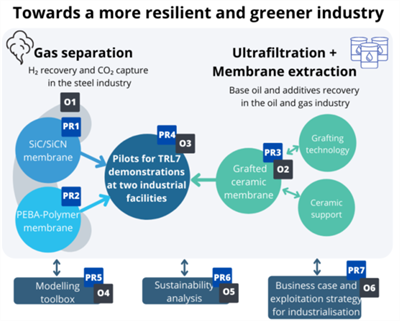by
Ali İzzet Cengiz | Dec 14, 2023
Project Manager: Prof. Ismail Koyuncu (Türkiye)
Overall budget: 7.763.052,00 EUR
In the calls of the 2022 under the Cluster 4 Industry Areas of the Horizon Europe Program, specifically under "Objective 1: Climate-neutral, circular, and digital manufacturing" and "Objective 2: Increased autonomy in key strategic value chains for resilient industries," 10 different projects have been awarded support by the European Commission. Within the scope of the HORIZON-CL4-2022-RESILIENCE-01 call, the project titled "Customised membranes for green and resilient industries (CUMERI)," led by Prof. Dr. İsmail Koyuncu from the National Membrane Technologies Application and Research Center (MEM-TEK), has been granted support. The project team includes Prof. Dr. Vahid Vatanpoor, Assistant Prof. Dr. Mehmet Emin Paşaoğlu, Assistant Prof. Dr. Recep Kaya, and Assistant Prof. Dr. Türker Türken.
The overall objective of CUMERI is to develop and demonstrate advanced and customised membrane systems for enhanced recovery of valuable components and improved energy efficiency at industrial facilities, while lowering CO2 emissions.

Project Objectives:
- Develop enhanced membranes for outstanding gas separation performances
- Develop finetuned ceramic membranes for used lubricant oil (ULO) and additives recycling
- Demonstrate at TRL7 the performance of the membrane systems for a more resilient and greener industry
- Develop advanced modelling and simulation to provide guidance for the selection of membrane systems
- Ensure the sustainability of the demonstrated membrane systems (including end-of-life considerations)
- Ensure maximum exploitation of CUMERI results for wide and rapid market penetration
All membrane systems aim to enable greater energy efficiency and reduced emissions within their respective industries. The goal is to achieve high separation performance alongside increased chemical, mechanical, and thermal stability. Additionally, the project aims to facilitate the reuse and recycling of membranes. Beyond these objectives, our project will generate new insights into membrane separation, including various flexible solutions, to accelerate the widespread adoption of separation technologies in the industry, scientific community, and among policymakers.
To maximize the impact of CUMERI, other promising separation technologies will be explored, and the transferability of results to other industries (such as refining, pharmaceuticals, etc.) will be ensured. Through its activities, CUMERI will promote the reduction of emissions in the industry, the increased valorization of valuable chemicals, and pave the way for more energy-efficient processes, thereby encouraging flexible and circular industrial value chains.